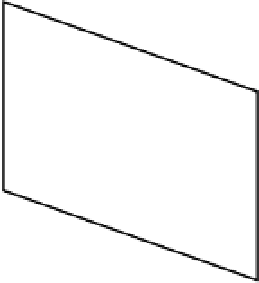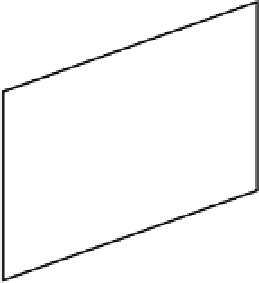Graphics Reference
In-Depth Information
X
x'
x
Figure 6.9.
Once the camera matrices are estimated, the 3D point corresponding to a given
feature match can be estimated by triangulation. The point is chosen as the midpoint of the
shortest line segment connecting the two rays.
An alternate approach to the above is to simultaneously recover the internal
parameters and the relative rotation/translation for a stereo rig by showing it multi-
ple images of a planar calibration pattern (an extension of Section
6.3.2
described by
Malm and Heyden [
312
]). We can also estimate the camera parameters by observing
the changing positions of feature correspondences as the rig is moved freely though
a stationary environment ([
202
,
109
]); two stereo views are minimally required for
zero-skew cameras. The latter approach is fundamentally related to the algorithms
for image sequence calibration that we discuss in more detail in the next section.
6.5
IMAGE SEQUENCE CALIBRATION
We now have the ingredients to discuss the main topic of the chapter, the problem
of estimating the varying internal and external parameters of a camera as it moves
freely through an environment. This problem of image sequence calibration is the
core of the
matchmoving
process required for virtually any visual effects shot that
composites 3D computer-generated elements into footage from a moving camera.
In computer vision, the process is also called
structure from motion
, since we're
estimating the coordinates of 3D points corresponding to image features (i.e., struc-
ture) as the camera position is varied (i.e., motion). We assume the camera is always
translating between frames, so that any frame pair is related by a fundamental matrix.
Just as in the stereo case, image sequence calibration contains an inherent pro-
jective ambiguity analogous to Equation (
6.30
). Therefore, the first step is usually to
estimate a
projective reconstruction
of the cameras and scene points that matches
the image feature locations as well as possible. This projective reconstruction is
then “upgraded” to what is called a
Euclidean
or
metric reconstruction
that dif-
fers from the true configuration by an unknown similarity transformation. Again,
Euclidean reconstruction is not possible without some additional assumptions about
the camera calibrationmatrices or the structure of the environment—but inpractical
scenarios these assumptions are usually easy tomake. Once we have a good estimate









